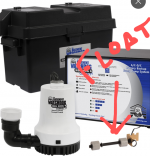- Location
- New Jersey
- Occupation
- Journeyman Electrician (retired)
If the pump is cycling on and off then it's not too small but you're correct that there is simply too much water entering the pit. That can happen around here where the pump won't run for months but get a few storms in a short period of time and it will cycle for up to a day.This is for someone sump pump in their basement. A pump that's running 10 seconds on and 10 seconds off is running half of the time and that would seem to be way undersized either for the sump pump itself or the sump, or there's just way too much water getting into the sump.


